|
FAQs on Wrasse Identification 2
Related Articles: Wrasses, Wrasses of the Cooks,
Related FAQs: Wrasse ID
1, Wrasses,
Wrasses 2, Wrasse Selection, Wrasse Behavior, Wrasse Compatibility, Wrasse Systems, Wrasse Feeding, Wrasse Disease, Wrasse Reproduction,
|
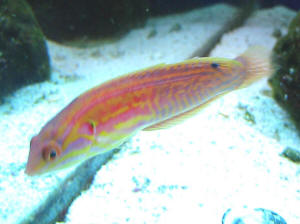
|
|
Marshall Island Wrasse ID help/request
8/15/19
<Oh yeah,
Halichoeres trimaculatus (Quoy & Gaimard 1824), the Three-spot Wrasse.
Indo-Pacific. To eleven inches in length. BobF>
Scott D Cohen
Sea Dwelling Creatures, Inc.
|
.jpg) |
|
Unidentified Wrasse, Labropsis manabei
7/12/19
Hi,
<Edwin>
Bought this wrasse and the fish shop identified it as a Tulip or Two-lipped
wrasse “couldn’t make it out”. Hope WetWebMedia can.
<Yeah; nice specimen. Please see here:
http://www.wetwebmedia.com/TubelipWrasses.htm
Bob Fenner>
|
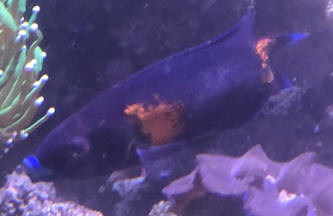 |
|
Re: Identify Wrasse
7/12/19
Disregard - identified as Northern Tubelip Wrasse. Thanks .
<Oh! B>
Re: Unidentified Wrasse
7/12/19
Feel free to use my pic as it does show the wrasse better - was taken using my
phone and is my tank.
<Okay; thanks. B>
|
|
Wrasse ID 3/21/19
Hi,
Can you please help in IDing this wrasse? Thanks.
<What the...?! Do you have other pix? Where was this collected (country,
habitat)?
Bob Fenner>
Re: Wrasse ID 3/21/19
Just this one. Collected from the Bay of Bengal, India
<Okay... will look a bit more when am back from diving. Have you used
Fishbase.org for the family and India? BobF>
|
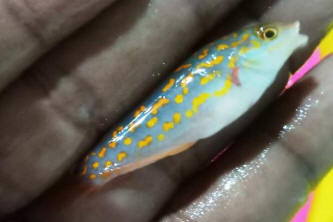 |
|
Re: Wrasse ID 3/21/19
It does look like Timor wrasse to me. Let me know your thoughts.
<Ah yes; I do agree. This does appear to be Halichoeres timorensis BobF>
Re: Wrasse ID 3/21/19
No I haven't Bob. Happy diving!
<Thank you Beta. B>
|
|
Pseudojuloides ID 2/18/19
Hi Team,
<Beta>
Can you please ID this wrasse and let me know if it's reef safe. Thanks.
<Yes, it is a Royal Pencil Wrasse (Pseudojuloides severnsi). It is reef safe.
Cheers. Wil >
|
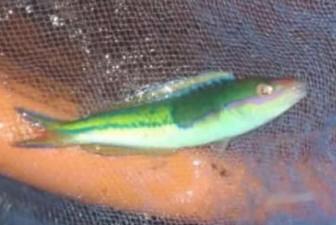 |
|
Re: Pseudojuloides ID 2/18/19
Thanks Wil
<You're most welcome. Wil.>
|
|
Wrasse ID 2/13/19
Hi Team,
Would appreciate an ID of the Wrasse. Unfortunately, this is the only pic that I
have.
<Mmm; def. a member of the genus Halichoeres. My first guess is on juv. to
initial phase Halichoeres hartzfeldii (Bleeker 1852), Hartzfeld's Wrasse.
Second guess is H. zeylonicus.
Bob Fenner>
|
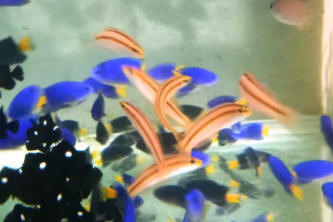 |
|
Need an expert opinion for identification
4/29/18
Hi, first thanks again for your last reply. The silicone issue is resolved and
no ill effects. So I ended up getting a wrasse from a supplier and it wasn't
what I expected. I ordered a lime green (aka sunset) wrasse and got
one that at first I thought was female due to the amount of yellow. After
questioning the store they told me it was a juvenile which I accepted as an
answer until I came across a purple and yellow wrasse advertised on
liveaquaria.com. I'm attaching photos of mine and the one advertised on live
aquaria. Thoughts? The only difference may be the spots but I see those on the
dorsal as well, just not as prominent.
<... the yellow white fish appears to be an initial phase/female Thalassoma
lutescens (Lay & Bennett 1839), the Yellow Moon Wrasse>
I also had one other issue. I've owned a wrasse before but it wasn't interested
in hermits. This one is really skilled and I was wondering what type of clean up
crew can survive in a tank with pred.s?
<Will likely eat hermits, possibly snails>
I would really like to ensure the food missed in feeding is getting taken care
of in the rocks but I wasn't sure what could handle that. How skilled are
Nassarius snails at living?
<Fine as long as stay hidden>
Do larger wrasses typically eat serpent stars?
<Some do; yes>
Anyway, again I'm hoping you're willing to share some expert advice, writing not
edible on the shells isn't working.
<I'd count on your maintenance and the gear to do the clean up here>
Thanks again!
The close-up titled download is the purple and yellow wrasse on live aquaria.
<This is a Halichoeres leucoxanthus. See WWM re both genera, species. Bob
Fenner>
|
.jpg) cropped...
cropped... |
|
Wrasse identification 2/14/16
Hey,
Was just trying to figure out what fish this is, thanks for the help!
<Ahh; a very nice juv. Puddingwife; Halichoeres radiatus. Bob Fenner>
|
 |
|
Re: Wrasse identification 2/14/16
Wow your good! Thanks so much.
<Heeee! Welcome. BobF>
|
|
Fish ID question
6/15/14
I recently received this fish from a local reef club member. They
collected it in Port Aransas Tx about a year ago.
<A really neat place... though quite a walk out!>
Thalassoma bifasciatum or Halichoeres maculipinna? Or....
<My guess is on the
former... a juvenile; though either species should have
changed after this time into an initial phase individual.>
Thanks in advance.
Robb M
Austin, Tx
<Ah welcome. Bob Fenner>
|
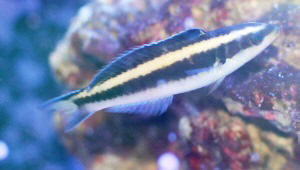
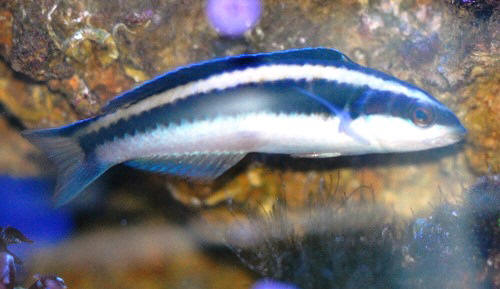 |
|
Wrasse identification 10/2/13
Hello WWM Crew,
I have attached a picture of a wrasse that is at my LFS. They do
not know what type it is as a guy brought it in who was getting out of
aquarium hobby. He didn't know what type of wrasse it was either.
I was wondering if you could identify it. I have searched wwm
archives and several other sites to I.d. this fish. I do not want
to buy a fish I know nothing about.
The fish is about 5 inches long and very active. I was wondering
if it was a Thalassoma wrasse of some type.
<Yes; the yellow band behind the pec, the color bands behind the eye...
Likely T. hebraicum>
Any help you could provide would be appreciated. Thanks again for
all you do you have made me successful at this hobby.
Kellylynn
<Thanks for sending this along. Bob Fenner>
|
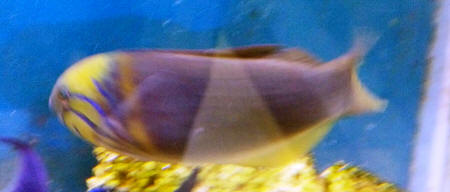 |
|
Fish ID/s... 1/11/13
Hi WWM Crew: Thank you for all the help you have given me over the year with
your helpful website, you have make this wonderful hobby much more
accessible to all of us and save me from many mistakes that I could have
make over the years. Thank you. I did something the other day
that I know I should not have. But it was love at first sight and I
don't regret it.
I went to my local fish store and took home two fish that I am not familiar
with. I know it was a Wrasses and an Anthias.
<One of both in your pic>
Beyond its beauty and cuteness, I don't know much about and as usual the
shop owner said it was easy to keep kind of fish.
<Mmm, not on the easy side in my opinion/experience. The Anthiine likely
lives (well) in a group setting... the Labrid is easily spooked, not
competitive w/ more eager eaters>
I took them home and now I realized I could not even ID them anywhere.
So please help me and let me know what kind of fish is it and how to take
care of them. I feed them two time a day with frozen Mysis shrimp and
they seem to be happy in the tank so far. I have a 75G tank with 120
Pounds of lives rocks, a hang on back protein skimmer, a hang on back
refugium and a canister filter. I do a 20% water change every other
week. Currently, other then the two new fish, I have a Lime Green
Wrasses that is about 4 inch long. Thanks again for all the help.
Patrick
<... The orange fish, the fancy bass... you'll have to search on the Net
re... I'd try Fishbase.org, the family Serranidae... the long haul of
viewing by genus (likely Anthias)... The wrasse appears to be a Halichoeres
species, H. melanurus?
Bob Fenner>
|
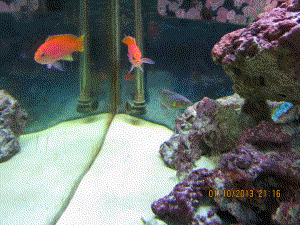
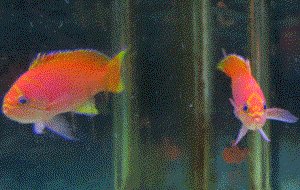
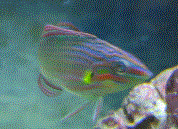 |
|
Fish ID 7/18/12
Hey Bob,
<Chris>
I hope that you're chilling somewhere sunny with a beer or three.
Question: any thoughts on hat this little bugger might be? I'm
assuming Halichoeres, but would appreciate any thought you may have.
It's 3/4" long.
<Wow! Small... I think this may be a juvenile Hemigymnus; perhaps H.
melapterus...>
Thanks,
Chris
<Welcome. Bob Fenner>
|
 |
Wrasse identification... by common names
6/22/12
A fellow aquarist is looking to get rid of this guy, calling it a
"sunset wrasse".
<Uhh, quite a few possibilities here>
I was unable to find a picture in the wrasse section, although it appears
it could be a Thalassoma?
<Could be, or a Halichoeres, or... Put the common name, search the
family members in fishbase.org...
http://www.fishbase.org/home.htm
Can you shed some light? Want to make sure he'd be happy in my
system before I purchase. Thanks.
<BobF>
|
ID 3/29/12
Hey Bob,
<Hi Chris>
Hope that you are well. Might you have an idea as to what
this guy might be? It's about 6" long ...
<Mmm, a Labrid/Wrasse of some species...
don't recognize it right off.
Would ask you to do the long read/search of pix on Fishbase.org
for the family. Start scrolling here:
http://www.fishbase.org/identification/specieslist.php?famcode=362&areacode=
Anything that looks close, click on the pic, and the subsequent
pix... Some species have a huge range of color/markings...
BobF>
Thanks,
Chris
|
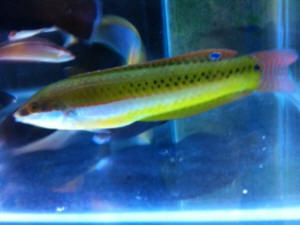 |
|
Re: ID, Labrid
3/30/12
Cool Bob, thanks. I did not know that this picture page
existed by species.
<Ah yes... a bit hard to find, but very worthwhile for
searches like yours>
Many thanks,
Chris
<Welcome. BobF>
|
|
Fish ID 2/10/12
Hey Bob and Crew,
<Chris>
Would you all be able to ID the attached Labrid? It was collected
in Western Australia and is about 4" long.
<Mmm, dang! The pic is a bit blurry... Have seen this
before... am out, away from home and print references... I think
this is either a Halichoeres sp. or Thalassoma... DO log on to
fishbase.org, bring up the Family (Labridae), and look through
the "show pictures" (there are many!) for the
Wrasses... Do you see it/this?>
Many thanks in advance.
Best,
Chris
<Welcome. Bob Fenner>
|
|
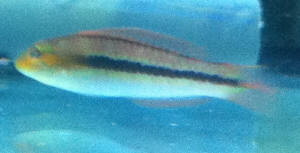
Re: Fish ID
-
3/10/12
Heh heh thanks Bob and apologies for the pic quality. I was
thinking it was a Thalassoma from the head and jaw as well. I
hope that your somewhere with warm water and cold beer!
Thanks,
Chris
<Thank you Chris. I did look through Fishbase and didn't
see anything very like this; nor in a general Google search for
wrasses of W. Australia. Am up in San Francisco, giving a talk at
the BAR club... water too cold for me, but dinner at one of the
Harry's Hofbraus was mighty fine... A Murphy's and a
Spaten and am good to go. Cheers, BobF>
Re: Fish ID
-
3/10/12
I do appreciate the looksie Bob.
<Certainly welcome. B>
Thanks,
Chris
|
|
Wrasse Identification Help
8/12/11
Hello crew,
<Chris>
I'm having difficulty identifying a wrasse I captured out in
a reef near where I'm currently living. I am at best guess
it's in the Halichoeres family, but I can't find anything
that matches exactly. Some of the specific notes I have on this
is that it is very similar in build to the Hoeven's wrasse,
however the coloration is very different. It has a blue laterally
lined body, merged dorsal and adipose fins red in color, with a
dark spot around the adipose fin area, another spot at the base
of the tail, the tail which is yellow, red anal fin, and bright
orange pelvic fins.
The pectoral fins are clear. I have attached a photo taken of the
fish.
<I see this>
When I see these fish in the reef, they tend to stay
approximately 6 to 8 feet down, unlike most of the other similar
wrasses, which usually reside within a couple feet of the
surface. I have yet to see a specimen of this coloration more
than 3". They seem extremely territorial towards other
wrasse of the same species, and occasionally an adult blue
damsel, although in their natural setting they rarely are at the
same depth. I captured 2 of them at the same time, however the
one pictured killed the other. I normally see them picking at
rocks and coral. The area I see these wrasse at is a rocky bay in
Okinawa, along rock walls dropping down about 8 to 10 feet to a
sandy bottom.
Christopher A Cole
<Mmm, my guess is on the genus Thalassoma... do see
fishbase.org for this genus... Bob Fenner>
|
|
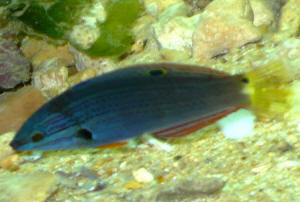
Re: Wrasse Identification Help --
08/13/11
Thanks, I've actually downloaded the entire Fishbase listing
for Okinawa (Ryukyus)(3697 entries) and Japan (1535 entries),
<Whoa!>
That is normally my first source for IDs when I encounter
something new.
<Is one of mine... and am out on the E. coast giving talks at
a fish health conference, so don't have access to my in-print
ref.s>
They don't have a picture that matches,
<Well... as you are likely very aware, there are MANY
variations on color and markings per some Labrid species... and
even a few as-yet, undescribed species>
but there is a large number without photos. I'm curious as to
why you said it was Thalassoma, vice Halichoeres.
<Thalassoma are more fusiform/tubular in overall profile...
which your one photo sent looks like to me... also this genus is
more prognathous than Halichoeres... whose many members are
typically more laterally compressed and truncate at the
head-end>
I found a Russian site identifying it as Halichoeres melanochir.
I Googled it to confirm, and most pictures returned looking very
similar. Again, thanks for the help.
<Thank you for sharing. BobF>
|
|
Help with an ID 4/27/11
Hey Bob,
Hope that you are well. Could you help me with an ID? I
originally thought it was a Bodianus, but am not too sure
now.
Many thanks,
Chris
Help with an ID 4/28/11
Sorry Bob,
<No worries>
My system kept kicking the bloody file off of the email. Just
double click the below.
Many thanks,
Chris
<Is Hologymnosus doliatus "Pastel Ring Wrasse" - a
juvenile. BobF>
|
|

|
Re: Help with an ID 4/28/11
Many thanks Bob. Much appreciated!
Chris
<Mmm, welcome Chris! BobF> |
red masked wrasse... No pic or sci. name --
04/03/10
I was at the local fish store and they had a red masked wrasse for
sale.
<Is this a Coris species?>
I would like to buy it but cant find much information about it. Is it
reef safe?
<... need to know the species. See here:
http://wetwebmedia.com/marine/fishes/FishInd1.htm
the second tray from the bottom>
I currently have a 55 gallon FOWLR.
<Too small>
The inhabitants are 2 cleaner shrimp, snails.
<Food items>
1 Cardinalfish, and a chalk sea bass. Would these be compatible tank
mates? Also is this fish fairly hardy?
Thanks for your help,
Chris
<Keep reading, searching, cogitating furiously, punctuated w/ rest
periods of course. Bob Fenner>
Re: red masked wrasse, now lifted image... still not
reading 4/3/10
Thanks. My main problem is that I can figure out the species but I
think I found a picture (Attached). Any help would be appreciated.
Thanks,
Chris
<Right. See where you were referred to last email. B>
|
Wrasse or not a wrasse? 4/2/10
Hello crew,
I have two main questions for you. First off, I bought what
appears to be some sort of wrasse from my LFS yesterday and they
were not able to identify it, but could only tell me it was not
the fairy wrasse that was in the same tank with it. I have it in
a newly established 25 gallon tank in which I have all the
necessary components to eliminate the chlorine and ammonia and
the like, as well as trace elements and a buffer solution. I
added a few hermits, snails, and the cleaner shrimp I had in a 5
gallon tank into this one and all seem to be doing fine. My
questions are, one, can you tell me if this is even a wrasse?
<Likely is a Labrid>
And if so what kind?
<Probably a Halichoeres species, judging by the head, mouth
and body shape, colour pattern. See here: http://wetwebmedia.com/halichoeres.htm
and the next alphabetical file linked below>
And two, he has been hiding in the substrate ever since I got him
and I have periodically poked around to scare him out to make
sure he was alive (about once a day) but he comes out for a
second then bury himself back in again. Is this normal even for
the daytime or could this be because he is in a new aquarium and
will take some time to get used to?
<Is to be expected... not to worry or poke... Needs a suitable
environment, time to settle in>
Or could it be a water quality issue? I checked on him a minute
ago and he is still alive but I am concerned. Thank you for your
help and your website is awesome.
Eric
<Welcome. Bob Fenner>
|
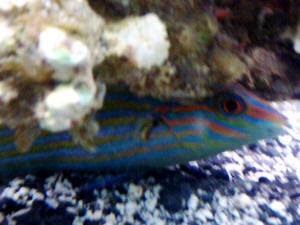 |
|
Wrasse??? 3/8/2010
Dear Bob,
<Tineke>
This fish puzzles me.. do you have a name for this one? I think
it is a wrasse when I look at the shape.. but I can't find it
in books and the internet.
Thanks for helping me.
This Picture is from Moalboal/Philippines
greetings,
Tineke
<Looks to be a rather juvenile, initial phase Halichoeres...
chloropterus.
Bob Fenner>
|
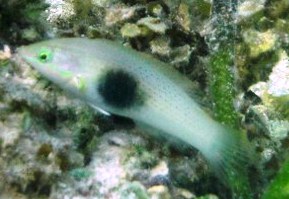 |
|
Re: Wrasse??? 3/8/10
Thank you, Bob. Again a name for a fish...it gives me great
feeling! Juv. Are sometime very hard to determine. not all the
pictures of these juveniles are on the internet or in books.
<There are a BUNCH for sure. Am hoping you and I can/will be
able to get out dive-traveling and contribute more images of all.
Cheers, BobF>
Hear you next time!
Tineke
|
|
Wrasse Identification help please? -Looks to be
Pseudodax moluccanus to me... 5/18/09
Hello again, sorry to bother you,
<No worries , is why we're here!>
but I've given it a good try and still can't find this
particular Wrasse in any book, on any website including
yours,
<Sometimes can be a challenge.>
and so I'm going to ask for help. It is possible that
it's just in a phase that isn't typically seen.
<Could be.>
I got him at Aqua Oceans in Lakewood, NJ.
<I'm in Pennsylvania, but haven't had the opportunity
to visit this store, or at least not that I remember.>
Steve thinks he's a Fairy Wrasse,
<Mmm, no. Is not a fairy wrasse.>
but he reminds me more of a Coris or leopard Wrasse....
<Yes.>
It is a dark maroon/red with bright but blue margins on it's
fins, tail the sides of it's mouth, and a slight blue tint on
the maroon of it's sides. Its tail has a bright yellow band
and then it's black or very, very dark red. And it's
little wing fins also seem to be yellow. It's not aggressive,
swims with it's mouth open a lot, but the inside edges of
it's mouth are bright white!
<Good description.>
Very pretty, and reminds me of a Leopard Wrasse in shape.....can
you help me
<Is a beauty! I believe this is a Pseudodax moluccanus
http://www.fishbase.org/Summary/SpeciesSummary.php?id=5594
http://www.wetwebmedia.com/marine/fishes/wrasses/
Should eat meaty foods, i.e. Mysis shrimp, even finely chopped
fresh shrimp or squid from the supermarket. If these aren't
tempting you might have to
try vitamin enriched brine shrimp or small grass shrimp. These
fish are a threat to ornamental shrimp and even small clams. May
also go after your Fanworms and possibly small Fireworms. This
fish should also be kept in tank with a sandy bottom as they
often bury themselves for protection. This fish generally
doesn't ship well, so you beat some of the odds.
Good luck!
Mich>
|
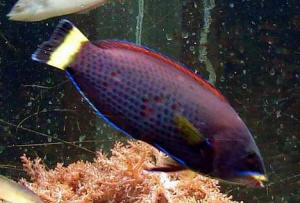 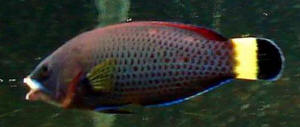 |
|
Halichoeres margaritaceus A Real "Mystery"
Wrasse...(Halichoeres ID) 1/15/09 Hello and I hope all
is well with you! <And I wish the same to you!> I have
emailed twice before asking after fish I haven't been able to
get much info on and been pleased with what I've gotten. So,
here is yet another email that will hopefully get the same
results. <I feel no pressure...no pressure! Scott F. here
tonight!> I work in a strip mall and there is a generic chain
pet store in it. I use it for food and scan the fish section
every once in awhile. I admit that I despise the idea of buying
from the store's livestock section as the employees are often
inept at best, shrimp not eating starfish is one of the wonderful
things I've been told (I have a Harlequin and I had to return
a CC star because the shrimp wasn't interested and I had no
intention of keeping the star long-term, not to mention they told
me the star wouldn't eat corals when I asked out of
curiousity). I've been going once a week for the past couple
of weeks and during those two weeks, they have had a
"mystery" Halichoeres wrasse. <I LOVE Halichoeres
wrasses...and I love a good mystery. My favorite group of
fishes.> I've looked all over your page, Fishbase, and
more, and the best match I found, though far from exact, is H.
margaritaceus. When I asked the employee about it, she had to go
ask the manager. He told me that the fish is a "Sea Grass
Wrasse" which it clearly is not. The animal in question is
about 3" so I thought it was possibly a juvenile, so I
checked to make sure the Sea Grass Wrasse doesn't have a
juvenile phase that looked like this fish. From what I could
find, it doesn't. <Ahh, the danger of common names- a
number of species of various genera go by this moniker! It's
a bit tough to determine what species you're talking about
based on this...A photo would really help! I'm thinking about
H. chloropterus as a candidate. This species is actually found in
seagrass/macroalgae biotope. Of course, this species looks
nothing like a H. margaritaceus, so I'm really grasping at
straws here!> So, after that long back-story, I find myself
very interested in purchasing this fish and I know I can sustain
a smaller Halichoeres quite easily, already having experience
with an H. chrysus in a smaller tank, but I am understandably
wary of purchasing a fish that I can't find much information
about or even ID for certain. <I agree with this thinking!
It's always a good idea to research a fish before you
purchase it...That cute little baby wrasse could grow up to be a
big old "tank wrecker"!> The fish is eating the food
fed by the shop, but it is a little thin for my taste. The tank
it's in now is probably ~20 gallons at best with some sand,
fake rock, and fake plants, which even with regular feeding,
could explain looking a little thin. The system the fish would be
going into is a -4 mo old, 65 gallon tank, ~87 lbs of LR 29
gallon planted refugium Octopus BH 800 S HOB skimmer Eheim 1262
return pump 1 Koralia 4 and 1 Koralia 2 -Tankmates are as
follows: 2 Neon Gobies 1 Ocellaris, 1 Percula 1 C. collare
(coming out of QT in a couple of days) Do you know if this is one
of the species that is more likely to destroy my CUC? The shrimp
mentioned earlier is in another tank, so he's not at threat.
Is the information about the fish's size on your page
correct, to about 5" in length? Is there any other pertinent
info about the fish I need to know? Thanks so much, Lisa <The
size range for this species is about right...However, I'm not
sure what a "CUC" is, so I really cannot comment on
what the fish will do! However, most Halichoeres species will
prey on some of the smaller crustaceans and snails in your
system, Some can be jumpers, so do keep the aquarium covered.
Well, that's all the generic tips on this genus I dare offer
at this juncture! Send pics! Good luck! Regards, Scott F.>
Re: Halichoeres margaritaceus "Mystery"
Wrasse (Pt. 2) 1/16/2009 Scott, <Hello again!>
Thank you for the help so far. I got a picture, but unfortunately
after trying for about ten minutes the best I could do was this
picture on a camera phone. The wrasse's body is a mottled
green and silver color while the fins are predominantly red with
what isn't red being clear or a beige-ish color and it does
have an "eyespot" on the dorsal. The cardinals seem to
be about average size for the fish, so hopefully that will give
you some idea of scale. I thought that this might have been
chloropterus at first as well, but not with this much red in the
fish. I asked about the origin of the fish, but the store buys
through "corporate" and so they have no contact with
the supplier or collector to find that out.
<Hmm...unfortunately, the angle/distance on the photo was not
so good in the picture! I'm at a bit of a toss up here as to
which species it might be. Definitely not H. chloropterus, IMO.
Perhaps H. schwartzi? It's just too tough to tell from the
picture.> By to the clean-up crew, which is just a mix of
snails and hermits in this tank. The snails are all probably too
big for the wrasse to fit in its mouth currently, but some of the
hermits are very small. The tank is covered. I learned the hard
way and just treat it as though all fish will jump, just in case.
Thanks again for all the help so far, Lisa <Glad I could help.
Just not sure what we're looking at yet. If you could only
get a better pic! Thanks for trying, though. Regards, Scott
F.>
|
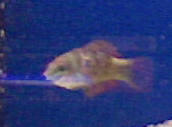
|
Re: Halichoeres margaritaceus
"Mystery" Wrasse- Case Solved! 01/19/09
Scott, <Hello again!> Hopefully not bothering you
with this response. <Of course not!> I posted the
same picture of the fish in a bag that I sent to you
recently on a well-known reef forum and got an ID from the
Director of Live Aquaria, Kevin Kohen. <A good guy-
he's seen lots of cool fish, so I'd value his
opinion.> He pegged it as Xenojulis margaritaceus, still
a wrasse, but the only fish in its genus and more closely
related to the Macropharyngodons than Halichoeres. I was
able to find the fish on Fishbase.org and it seems to be a
match. Do you agree with this ID and have any further info
than what is available on Fishbase? Thanks again, Lisa
<Looking at the close-up that you provided with this
email, I would tend to agree that it looks way more like a
Macropharyngodon than a Halichoeres, indeed! I think he
made a good call!. Unfortunately, I have had no experience
with this particular fish/genus, so I would have to defer
to what you can find in FishBase or other scientific
literature. Perhaps some of our readers do have experience
with this species, they will share their knowledge! Good
luck, keep good notes, and I hope that YOU will be able to
add to the body of knowledge on this fish. Regards, Scott
F.>
|
 |
|
|
Yellow Wrasse QT 08/12/2008 Hello, <<Hi there,
Andrew here>> I recently purchased a ****Yellow Wrasse****
and have him in QT. The reason for writing you today is in
regards to a question submitted on 08-12's FAQ by another
regarding his QT of a Yellow Wrasse. Eric mentioned that QT is
not necessary with this type of fish and I am curious as to why,
in this case, you do not need to QT it. I am not questioning
Eric's recommendation, as I am sure he is more than
qualified, just trying to further my knowledge. <<Regarding
this wrasse species, can you please be more specific, as the
common name of "yellow wrasse" is given to a few, which
have different needs / sizes etc etc. Please review here,
including linked articles and FAQ's, identify your specific
wrasse, and then re-submit your query. Its always best for us to
provide answers based on specific information, and not to
generalise common names or assumptions.
http://www.wetwebmedia.com/marine/fishes/wrasses/index.htm
http://www.wetwebmedia.com/marine/fishes/wrasses/coris/index.htm
http://www.wetwebmedia.com/halichoeres.htm >> Thanks, Shawn
<<Look forward to receiving your reply and species info.
Regards. A Nixon>>
Re: Yellow Wrasse QT 08/14/2008 I believe it
to be Halichoeres Chrysus. Thanks again, Shawn <<Intrigued.
Could you point to the page on which you read this, had a look,
could not find myself. Personally, yes, I would quarantine for a
few weeks. A Nixon>>
|
Sail-fin Wrasse? 2/6/08 First, let me thank
you for all the information your site provides. Generally, with some
diligence, I find almost any information I need to care for my FOWLR
tanks on your site. <Ah, good> However, I'm a bit stumped at
this point. Recently my LFS got in a gorgeous Labrid identified by
their supplier only as a "sail-fin wrasse". The store owner
and the store manager know of my fondness for wrasses and their kin,
and asked me to take a look at it, even offering to sell it to me at a
discount after it passed their store quarantine if I could figure out
what the heck it was. It's been a more than a bit camera shy, so
I'm unable to provide a picture. It's a small wrasse (if
it's an adult), being only about 3 inches long. Overall, the color
is a deep reddish brown to maroon, depending on the light, with the
dorsal and tail fins being very dark, shading to a rich deep blue at
the edges. The body and fin shape remind of the "fairy
wrasses" or small hogfish, but the shape of the mouth seems wrong
for either of those. The mouth area is almost purple, and based on the
shape of that mouth, I think I'm looking at a Labropsis of some
sort, with my best guess so far being L. manabei. (This is based on
flipping between the wrasse section on your site, and Fishbase, and
staring at picture after picture). Habit-wise, it seems to be
moderately shy, and the first time it was given a sand bed to burrow
in, it quickly did so. It's feeding well, accepting both flake and
frozen foods, and shows no sign of injury or illness. So, with Google
having failed me, have you ever heard of a "sail-fin wrasse"?
J Stoddard PS: I apologize in advance for any extra question marks my
mail client may decided to toss in. <Mmm, the message is extra
mark-free, and clear in its writing, intent... I don't know what
this is by its description. REALLY need photos... there are quite a few
unknown Labrids. Bob Fenner>
Underwater Fish Encounter, Questions RE, TWA
Labrid ID 8/16/07 Good Day WWM Crew-- <Eric> Your website is
such an AMAZING wealth of knowledge and has helped me MANY times!!
<Ah, good> This is not necessarily an "aquarium
related" question... but specific to marine fish.... A few months
ago I was lucky enough to go snorkeling in the Caribbean, mainly off
the shores of St. Thomas and St. Maarten. This was very exciting.. as
I'm sure you all know. I LOVE IT!! and want to go diving very
soon... Anyway-- I almost (accidentally of course) stepped on a 2-3ft
wide Stingray when swimming on the surface of about 3 feet of water
that emerged DIRECTLY under me, and swam away, just as I was about to
step down in the sand. That was exhilarating, to say the least! Good
thing I didn't make contact. <Yes> Also, I saw many amazing
things and different fish, but have one specific question. In about 10
ft of water, I went down toward the bottom, and looked up. Almost
immediately, there was a smaller sized school (probably 10-20) fish,
each between 6-12 inches in length formed a circle and swan around me,
one fish behind the other in close succession, with me at the center.
The diameter of the circle was probably 6-8 feet or so.. They were
bright blue, and the best way I can describe them is as follows":
They look like a cross between Yellow Tang-ish and Damsel fish bodies,
but were much more "stretched out".. Close to a Foxface Lo
body shape, without the long nose and or "spikes"... maybe
close to an Anthias, especially the tail section... but this isn't
a great match either... very vibrantly colored blue as well. They look
like nothing (no exact match) I have seen in all my reading of the WWM
site, nor through looking at every (yes, every marine fish) on the
Dr's Foster and Smith Website. I tried fishbase.org but that site
is a list of scientific names... <An apt description of what many
folks don't recognize as a Wrasse/Labrid... the Creole Wrasse,
Clepticus parrae (Bloch & Schneider 1801)> I know this is a wide
opened question, with many possibilities, but any help
(suggestions/websites/etc) would be great! Also, have you heard of/seen
this behavior (circling around me) while diving? <Heeeee! Yes...
lucky they didn't all take a small bite! Just kidding. Cheers, Bob
Fenner> Thanks!!! Eric
New shots for you - 4/28/07 Dear Bob,
<Tanaka-san!> How do you do ? I hope you and family are very
well. <Thank you my friend, yes> I got some rarities and took
shots; some for your web. You may choose some from them. If you need
photos in higher res please let me know and thank you. All The Best,
Hiroyuki <Thank you my friend. Will post with credit to you. Bob
Fenner>
Choerodon (Lienardella) fasciata mis-labeled as Coris?
4/5/07 Good morning, Crew! <Hi Aaron.> I have a quick
question regarding Wrasse ID in a LFS. <Okay.> I've read
through many Fishbase pages and the pages on WWM regarding Wrasses and
I have yet to clear this up. <...I'll see what I can do!> My
question is, is there a wrasse that looks similar to the Harlequin Tusk
in adult stage? <The Harlequin Tusk; Choerodon (Lienardella)
fasciata is probably the most common species of the genus imported for
hobby use. Of the other species of the genus brought in (not very many
or very often) none (in my view) have nearly the outward physical
appearance (colorwise...not shape wise) of the harlequin tusk. So my
answer in one phrase, "None that you are likely to see.">
My LFS has two fish that look exactly like the Tusk and they have them
labeled as "Orange Coris Wrasse". <Not even same
genus...> The reason I ask is that they've been in the store a
couple of weeks and I'm tempted to buy one, but I'm not sure a
Coris would be a good choice in a softy reef. <Neither would the
tusk likely.> Any help you could provide would be greatly
appreciated. Like I said, the pics you have for the Tusk look EXACTLY
like the fish in the store, which leads me to think maybe they were
sold some tusks at a low price and I've found a great buy! <I
wouldn't put it past your average LFS to make a mistake now and
again.> Thanks! <Of course.> Aaron <Adam J.>
Wrasse Identification 2/6/07 ... no pic. Hi.
<Hello> I've been searching through your website for quite a
long time and just want to let you guys know that its great!
<Thanks> Either way, recently I bought a wrasse from a retail
shop and the guy didn't know what type of wrasse he sold me and I
really want to know. Its about 1.5 inches, is a pale red and has a
ginormous black dot on his tail. <Many possibilities here, please
look through the listings on WetWeb and check out fishbase.org for
more. Not enough information to go on here. Also please in future
queries spell and grammar check your message before submitting.>
<Chris>
| Please id my wrasse.... 12/17/06 Hello-we
have had him/her for about 6 months. He hasn't changed too much
in color - but he is bigger and fatter!) and his dark brown stripe
now goes to his tail and he seems to have very light blue /pink
lines as well. He sleeps in the sand like my red Coris. I have
researched many sites and have not found him. Thanks! ML Jones
<I make this out as an initial phase Halichoeres zeylonicus:
http://www.wetwebmedia.com/halichoeresn-z.htm A nice
specimen at that! Bob Fenner> |
|


|
Peacock Wrasse - 10/19/2006 Dear Ocean Kings: <Omg
sorry I read this and was laughing so hard at the picture of Bob Fenner
with a crown on his head and his Hawaiian shirt! Laughing here.>
Several years ago I had a marine aquarium and had great success. I
didn't try a lot of different things or add a lot of different
fish, so that may explain why... I had to sell the aquarium when I
moved to a different state. <That always sucks.> Anyway, I am
going to get another and would really like to get another peacock
wrasse. I had a blue damsel, a yellow tang and a peacock wrasse (in a
55 gallon tank). They got along great, stayed healthy and were a lot of
fun. The wrasse especially had a great personality. I have looked
through TONS of pictures trying to find the same kind of wrasse but
when I look up peacock wrasse" they are nothing like the one I
had. <Unfortunately, there is no standard in names. Most stores pass
along the name that their distributors give them and that can vary
widely.> My wrasse was a combination of vivid blues, teals,
greens--absolutely gorgeous. Not spotted. Perhaps a strip or two but
nothing that stood out a lot. About 6 inches long. Dove into the
crushed coral to sleep at night. He (she) would even eat out of my
hand, not at all shy. Unfortunately, I don t have any pictures. In
researching, it is shaped very similarly to the Thalassoma or
Halichoeres wrasse. <I'm going to assume you looked at the
pictures on http://www.wetwebmedia.com/thalassoma.htm, and didn't see
him because to me that sounds a lot like a lunare wrasse. I also
wondered if perhaps it wasn't a parrot fish instead of a wrasse
that you had. Fishbase.org is where I go when I want to figure out a
fish identification. Unfortunately there is no way for me to know what
your fish looked like but what I would do is go there and search under
the two that look the most similar to what you remember and then click
on the picture to see all the different versions of the fish. You may
find one that is exactly what you remember in some of the variations of
the fish. One word of caution, if it does turn out to be a parrot fish
you do need to consider at least a 100 gallon tank to keep this fish
long term. Good luck, MacL.> Do you have any idea which wrasse it
might be? (And, yes, after reading your columns, I DO expect miracles
from you guys! :-) Thanks, Tammy <<Likely a species of what's
also known as "Razorfish"... a few genera of Labrids...
RMF>>
Red Coris Wrasse? 8/31/06 Mr. Fenner, <Lisa>
I'm really not sure if this is the correct fish. I believe its a
Red Coris- (Coris gaimard) This fish is not that color is it black, but
it has orangish pectoral fins and some blue on its back fin and anal
fin. I'm hoping that you are able to help me out. Sincerely, Lisa
Scott <? Please see here: http://www.wetwebmedia.com/marine/fishes/wrasses/coris/index.htm
and fishbase.org... Do you have a pic to send along? Bob
Fenner>
Green Wrasse and Ich? Labrid ID, Disease 7/18/06 Hi
Crew, <Lynne> I just bought a Green Wrasse <Gomphosus
varius?> from my LFS on yesterday (Sunday). He's a solid size at
about 2 and a half inches long. <... male coloration at this size?
Maybe this is a Halichoeres species...?> I acclimated him to my QT
where he is now. He is eating heartily and is starting to swim around
and explore the tank after an initial 24 hour period hiding behind a
rock. I looked him over very closely at the store and he appeared to be
very healthy and a very active swimmer. I did not see any blemishes or
spots and there were no other dead or unhealthy looking fish in the
tank he came out of. I purchased him because everything I've read
about Wrasses is that they are very hearty and disease resistant.
<Umm, no... the family Labridae has a huge span/range of suitability
for aquarium use. Some species, genera rarely live...> The store
clerk said Wrasses rarely get sick because they have a very heavy slime
coat. <Incorrect> When I was feeding him tonight (Monday) I
noticed what appears to be 2 tiny white spots on his back fin. He has
been hanging out in the sand but the spots do not look like sand stuck
to his fin, although I suppose they could be. I'm really starting
to get concerned as I paid $60 for him and I am sooooo paranoid of Ich,
that is why I quarantine all my new arrivals for a solid 30 days before
moving them to the display tank. Do you think I should be concerned
about Ich with this Wrasse and how long do I wait before treating him?
<... Till it appears that this is really parasitic> I do not want
to treat him unless it is absolutely necessary. Any advice would be
very much appreciated! Thank you very much. <Please read here:
http://www.wetwebmedia.com/marine/fishes/wrasses/index.htm and
the linked files above. Bob Fenner>
USW - Unidentified Swimming Wrasse 12/10/05
Hi Bob, <Bob is out diving just like you were, and I bet
he's taking pictures too. Today you get Adam helping you
out.> I wonder if you can help me to identify the wrasse on the
attached photo? The picture is a video capture taken in about 30
feet of water off Pacific Harbour, Fiji. As you can probably see
there were a small group living with damselfish round a small coral
head on a wreck. <Very nice picture, your wrasse looks to be a
Thalassoma lunare, most folks just refer to it as the Lunare
Wrasse.> Many thanks
<Quite welcome.>
Colin
<Adam J.> |
|
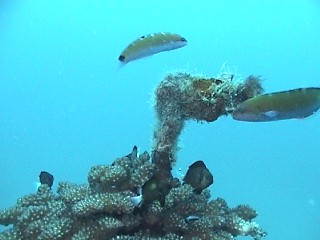
|
No ID what this Wrasse is! I am trying to
find a certain wrasse. I have searched online but unable to locate.
Unfortunately, I do not know what it is called. <Generally that is
the case ;-) > It is solid yellow with three small black dots
towards the back of the dorsal fin and has a pinkish tail...?
<Hmm...sounds to me like a Canary Wrasse, Halichoeres chrysus. See
the following page for more info on this genus: http://www.wetwebmedia.com/halichoeres.htm.
Best of luck, Mike G >
Wrasse Identification Hi, I have been
eyeing a wrasse at the LFS for the last few weeks and decided to
finally pick it up. Because it kind of just laid around I wasn't
sure of its health especially as I hadn't seen one like this
before. <Likely a Thalassoma lutescens: http://www.wetwebmedia.com/thalassoma.htm
> Most wrasses I have had/have are energetic swimmers. <Mmm, many
species spend a considerable amount of time sitting about on or in the
substrate> But, I attributed this to its housing at the LFS, which
was a small cube. It was labeled generically as Green Halichoeres
Wrasse. But, he was unusual so picked him up after seeing him digging
and apparently healthy after a few weeks, though still not swimming
much. I got him home and acclimated him. After releasing him, he just
fluttered to the bottom (44 gal corner, with 2 small Chromis). I had
brought water to the LFS before buying for a test and everything was
nominal (8.3ph, 1.022 salinity, 0 ammonia, nitrates, nitrites).
It's a well established tank that I recently moved some fish out of
and to another tank. He "rested" upside down for hours, but
his eyes showed he was awake and aware as they were looking around
constantly. I had seen this somewhat before with wrasses being paranoid
or scared and usually digging in for a while. Later at night he hid
behind some rocks, then finally came out and swam close to the bottom
for few minutes and then used his head as a shovel and dug a hole for
the night. This took about 10 minutes, then he finally did that
squirming I'm used to for wrasses to get the rest of his body under
the sand. This following morning (got him yesterday) he was back behind
some the rock wall lying down, but again his eyes were alert and was
respiring normally. He doesn't move, at all, quite unlike other
wrasses. I am hoping with identification, maybe you can shed some light
on his name and habits so I can see where I stand with this new fish.
He is your standard wrasses shape, closer to a dragon wrasse in shape
with less ornamental fins, bright green though. In addition he has
enormous canines similar to my Harlequin Tusk. I have attached 4 pics
from when I was acclimating him (I figured this would have been the
only chance to photograph him standing still, apparently I was wrong).
Thanks as always. Scott <Use the scientific name... your search
tools... Bob Fenner>
Re: Wrasse Identification Thanks for the
quick reply. I looked at the Thalassoma lutescens, but the one I have
looks nothing like the aforementioned fish (Green Moon wrasse). The
Thalassoma lutescens looks very similar to my lunar wrasse, but this
one has a completely different mouth. It has huge canines and cannot
close its mouth with them as they are so pronounced, much like my
Harlequin Tusk. Is there any other species you might think it could be
that I may be able to research? I looked at your wrasse pages and
nothing looks similar. Thanks again, Scott <... the genus Thalassoma
wrasses do have "large canines"... did you look at the pix on
fishbase.org, Google images of this species? Take a look again
please... at the pix you sent us. Bob Fenner>
Splendid Wrasse?? Can't identify! Hi guys--I really
tried to scour your FAQ's and website, but I can't seem to get
a handle on a fish I recently bought at LFS--I was told it was a
"splendid wrasse"--it's mostly yellow with bright blue on
edges of dorsal and pectorals, a bright yellow tail, broken blue
horizontal (but not distinct) body lines, and the most notable, a vivid
blue vertical streak running top to bottom through the eyes. Where can
I identify this guy? He's about 3", mixing well in a community
reef tank of 65 gals, plus 25 refugium. Can you help me here?
Thanks........Barry <Barry, There are many different types of
wrasses out there and with out a picture to identify it I can't
help you. I would suggest going to this web site and seeing what you
can find
|
|

